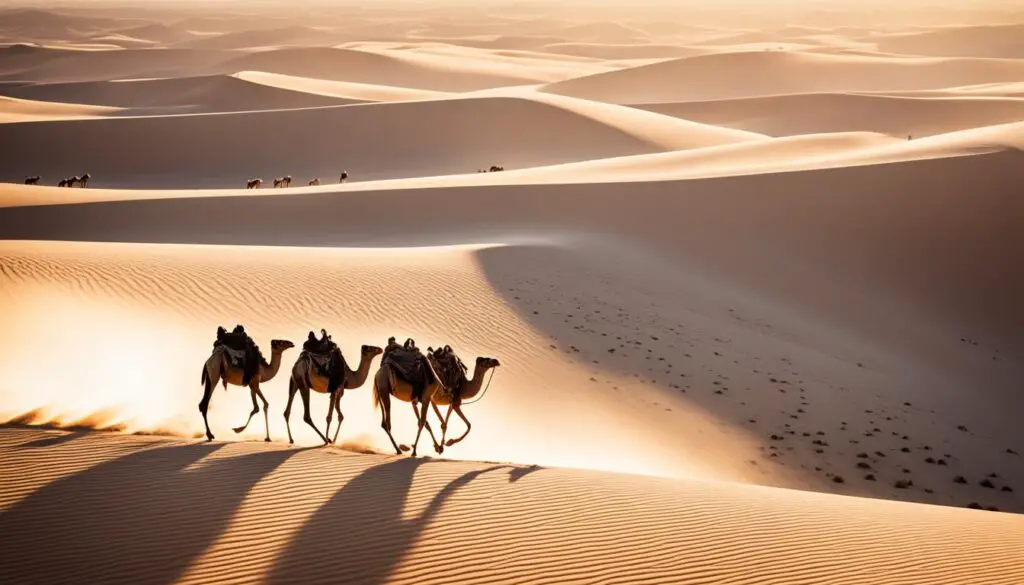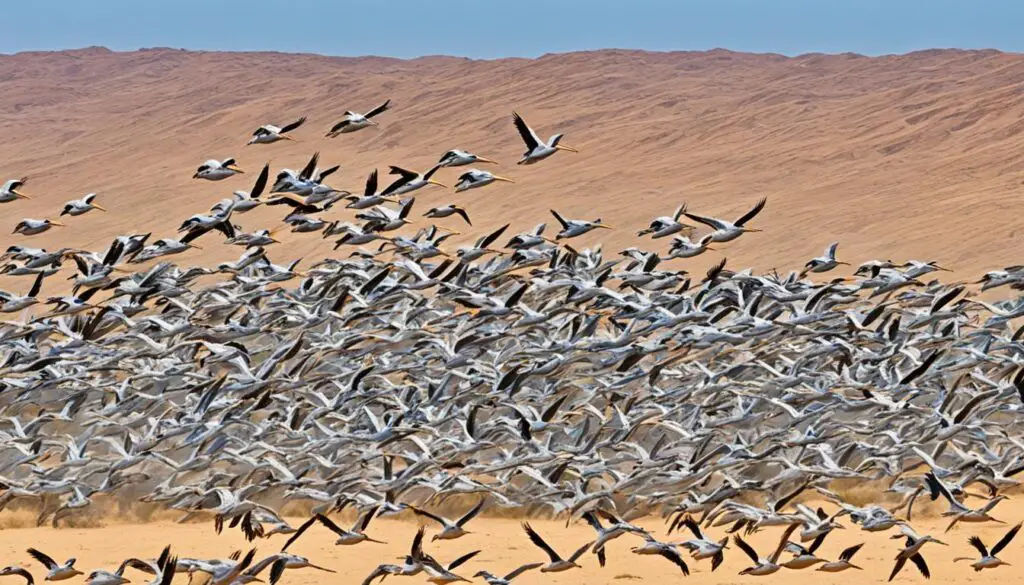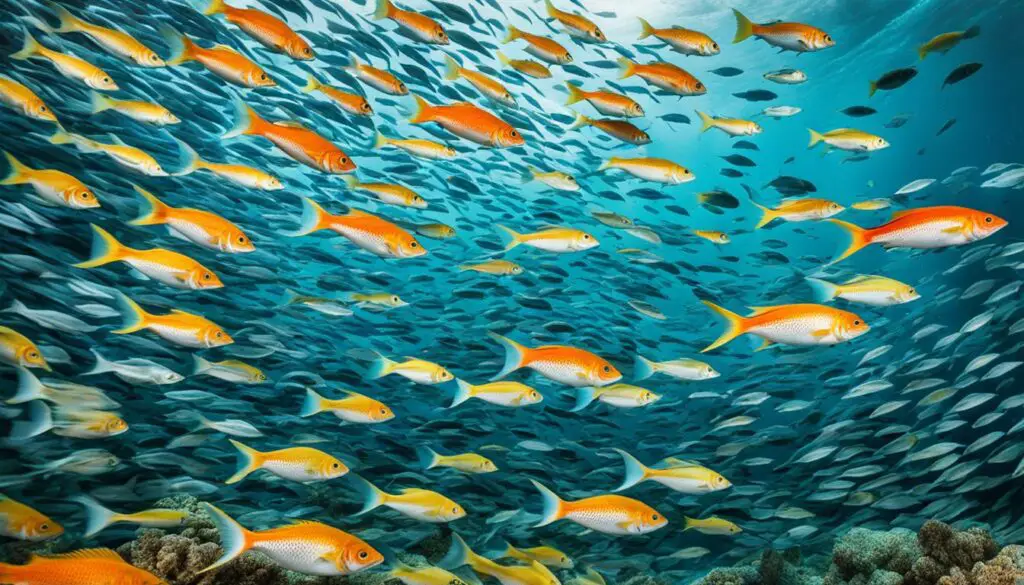Did you know that Mauritania is home to a remarkable range of animal species? From the vast deserts in the north to the diverse ecosystems in the south, this West African country boasts a wealth of wildlife that is sure to captivate nature enthusiasts. Whether you’re interested in Saharan creatures, migratory birds, or reptiles unique to the region, Mauritania offers a truly remarkable and diverse fauna.

Key Takeaways:
- Mauritania’s wildlife is influenced by its location in two biogeographic realms – the Palearctic and the Afrotropic.
- The country is known for its unique fauna, including Saharan creatures in the north and desert wildlife in the south.
- Mauritania is an important wintering area for numerous migratory birds from the Palearctic.
Faunal Regions and Habitats in Mauritania
Most of Mauritania’s north, up to approximately 19° north latitude, is considered to be in the Palearctic realm. This region is largely made up of the Sahara desert and adjacent littoral habitats. The south of Mauritania is part of the Afrotropic realm, with a predominantly Afrotropical distribution of species. The country’s habitats include the Sahara desert, Sahelian acacia savanna, and West Sudanian Savanna.
Mauritanian Fauna
The diverse habitats of Mauritania support a rich array of wildlife, making it a fascinating destination for nature enthusiasts. From the vast expanses of the Sahara desert in the north to the lush savannas and wetlands in the south, the Mauritanian fauna showcases a unique blend of species adapted to survive in the harsh desert environment and the diverse ecosystems of the Afrotropic biogeographic realm.
Saharan Creatures
The Sahara desert dominates a large part of the northern region of Mauritania. This arid and inhospitable landscape is home to a variety of Saharan creatures that have evolved to withstand the extreme conditions. From the iconic dromedary camel, known for its ability to endure long periods without water, to the elusive sand fox and gerbil, the Sahara desert harbors a surprisingly diverse range of species that have adapted to the challenging desert environment.
Afrotropic Biogeographic Realm
The southern part of Mauritania falls within the Afrotropic biogeographic realm, characterized by a unique assemblage of fauna adapted to the tropical and subtropical climates. Here, the Sahelian acacia savanna and the West Sudanian Savanna provide habitats for a wide variety of mammals, birds, reptiles, and amphibians. Species such as the African elephant, West African lion, and Nile crocodile can be found in this region, along with numerous endemic and migratory bird species.
To truly appreciate the remarkable Mauritanian fauna, one must explore the different regions and habitats that make up this diverse country. Whether it’s venturing into the vast expanse of the Sahara desert or exploring the lush wetlands of the south, Mauritania offers a rich tapestry of wildlife that reflects its unique location at the crossroads of the Palearctic and Afrotropic realms.
| Region | Main Characteristics |
|---|---|
| Sahara desert | Arid and desertic landscape with extreme temperatures and sparse vegetation. Home to a variety of Saharan creatures adapted to the harsh desert environment. |
| Sahelian acacia savanna | Transition zone between the Sahara desert and the West Sudanian Savanna. Characterized by acacia trees and grasslands, supporting a diverse range of wildlife. |
| West Sudanian Savanna | Lush savanna with a mix of woodland, grassland, and wetland habitats. Supports a rich variety of mammals, birds, and reptiles, including endemic and migratory species. |
Wetlands and Protected Areas in Mauritania
Wetlands are an important feature of Mauritania’s ecosystem. They provide critical habitats for a variety of species, support biodiversity, and contribute to the overall balance of the environment. Two significant protected areas in Mauritania that safeguard these wetlands include the Banc d’Arguin National Park and the Diawling National Park.
The Banc d’Arguin National Park is situated along the country’s coastline, protecting a vast expanse of rich, shallow coastal and marine ecosystems. These wetlands, integrated with the arid Sahara desert, create a unique and diverse habitat for numerous species of plants and animals. The park is particularly renowned for its importance as a breeding ground for migratory birds, making it a significant area for birdwatching enthusiasts. With its striking landscapes and remarkable biodiversity, the Banc d’Arguin National Park is a treasure that must be preserved and cherished.
The Diawling National Park is located in the delta of the Senegal River, encompassing a unique wetland ecosystem. This park plays a crucial role in conserving the biodiversity of the region, safeguarding the delicate balance between water and land. The Diawling National Park is home to a wide range of species, including migratory birds, mammals, reptiles, and amphibians. It serves as a sanctuary for various endangered species and contributes significantly to the conservation efforts in Mauritania.
Wetlands in Mauritania are predominantly ephemeral, relying on seasonal rainfall. These dynamic ecosystems undergo constant changes in response to the changing climate patterns and environmental conditions. Despite their temporary nature, wetlands play a vital role in supporting migratory bird populations, acting as critical stopover sites during their long journeys.
Mammals in Mauritania
Mauritania is home to a diverse range of mammal species, including both extinct and extant ones. Over the years, several larger mammal species have gone extinct in Mauritania, leaving a void in the country’s wildlife. Some of these extinct species include the scimitar-horned oryx, addax, korrigum, and dama gazelle. These majestic creatures, once prevalent in the region, have sadly disappeared from the Mauritanian landscape.
Additionally, there are mammal species in Mauritania with an uncertain status, such as the bohor reedbuck and slender-horned gazelle. These species are facing threats and challenges that make their conservation status precarious. Efforts are being made to assess and protect these populations to ensure their survival in the future.
However, despite the declines and extinctions, there are still several common extant mammal species in Mauritania. These resilient creatures have managed to persist in the country’s varied habitats. Some of these mammal species include:
- Fennec fox: Known for its large ears and sandy-colored fur, the fennec fox is well-adapted to the desert environment of Mauritania.
- African golden wolves: These social predators can be found in the Sahel region of Mauritania.
- Warthogs: With their distinctive tusks and warty facial features, warthogs are a common sight in Mauritania.
- African wildcats: These elusive feline predators inhabit various habitats across the country.
- Cape hares: Cape hares are known for their incredible speed and agility, making them well-suited to the Mauritanian landscape.
- Patas monkeys: Found in the Sahel region, patas monkeys are known for their distinctive reddish coat and long limbs.
These extant mammal species contribute to the ecological diversity of Mauritania, playing important roles in the functioning of their respective ecosystems. Efforts are ongoing to study and conserve these species, as well as raise awareness about the importance of preserving their habitats.
| Extinct Mammal Species | Status |
|---|---|
| Scimitar-horned oryx | Extinct |
| Addax | Extinct |
| Korrigum | Extinct |
| Dama gazelle | Extinct |
| Bohor reedbuck | Uncertain status |
| Slender-horned gazelle | Uncertain status |
Birds in Mauritania
Mauritania is a paradise for birdwatchers, with over 500 species of birds recorded. The coastal wetlands of Mauritania are of immense importance for over two million wintering Western Palearctic waders, including dunlin, bar-tailed godwit, and curlew sandpiper. The Banc d’Arguin National Park is a key protected area that supports a diverse range of bird species, including the great white pelican, Caspian tern, and grey heron.

The Banc d’Arguin National Park is located along the Atlantic coast and covers an area of approximately 12,000 square kilometers. It encompasses various ecosystems, including coastal dunes, shallow coastal waters, and mudflats. These habitats provide feeding and breeding grounds for a wide variety of bird species.
The park is especially important for migratory birds that use the coastal wetlands as a stopover during their long journeys. Every year, thousands of migratory birds pass through Mauritania, taking advantage of the abundant food resources in the coastal wetlands.
The great white pelican is one of the iconic bird species found in the Banc d’Arguin National Park. These large birds can be seen congregating in large flocks, feeding on fish in the shallow coastal waters. The park is also home to the Caspian tern, which is known for its distinctive red bill and large size. Other notable bird species include the grey heron, Eurasian spoonbill, and osprey.
In addition to the Banc d’Arguin National Park, other coastal wetlands in Mauritania, such as the Diawling National Park, provide important habitats for birds. These wetlands are characterized by their rich biodiversity and serve as breeding grounds for many species.
Overall, the diverse birdlife of Mauritania and the protection of its coastal wetlands are of great ecological significance. These habitats not only support resident bird populations but also attract migratory birds from around the world. Bird enthusiasts and nature lovers alike can experience the wonders of avian diversity in the beautiful and pristine landscapes of Mauritania.
Reptiles and Amphibians in Mauritania
Mauritania is home to a fascinating array of reptiles, showcasing the reptile diversity of the region. From the iconic West African crocodile to the elusive African chameleon, these reptiles play a vital role in the Mauritanian ecosystem.
One of the standout reptiles found in Mauritania is the West African crocodile (Crocodylus suchus). This majestic species is native to the region and can be found in various water bodies across the country. The West African crocodile is a critically endangered species, highlighting the importance of conservation efforts to protect its habitat and population.
In addition to the crocodile, Mauritania is also home to other reptiles such as the Nile monitor (Varanus niloticus) and a variety of geckos and lizards. These reptiles contribute to the rich biodiversity of the country and are a testament to the diverse range of habitats found in Mauritania.
Overall, Mauritania has recorded a total of 86 species of reptiles belonging to 21 families. This variety highlights the significance of the country as a habitat for reptiles and emphasizes the need for conservation efforts to ensure their survival.
Amphibians in Mauritania
While reptile diversity is abundant in Mauritania, the country’s amphibian population is comparatively lower. Currently, Mauritania has confirmed the presence of 11 amphibian species. However, there are expected to be 19 more species yet to be recorded, primarily in the southern part of the country.
The southern regions of Mauritania offer more suitable habitats for amphibians, including various wetlands and marshes. As research and exploration continue, we can expect a better understanding of the amphibian diversity in these areas.
| Reptile Species | Number of Species |
|---|---|
| West African Crocodile | 1 |
| African Chameleon | 1 |
| Nile Monitor | 1 |
| Geckos and Lizards | 83 |
Fish in Mauritania
The waters off the coast of Mauritania are teeming with a diverse array of marine fish species, making it a valuable resource for both commercial and subsistence fishing. The potential catch in these waters is estimated to be between 400,000 and 700,000 tons annually. From the European seabass and European hake to larger predators such as the whale shark, Atlantic bluefin tuna, and Atlantic sailfish, the marine fish population in this region offers a range of opportunities for fishing enthusiasts.
In addition to marine fish, Mauritania is also home to a variety of freshwater fish species. Inland, the country has reported a total of 56 different species of freshwater fish. These freshwater ecosystems contribute to the overall aquatic biodiversity of Mauritania, providing additional fishing opportunities for locals and visitors alike.

With its abundant marine fish and diverse freshwater fish populations, Mauritania offers a rich fishing experience for both recreational anglers and those who depend on fishing for their livelihoods. Whether you’re casting your line in the open waters or exploring the inland freshwater habitats, Mauritania’s fish species are sure to provide an exciting and rewarding fishing experience.
Conclusion
Mauritania’s unique location and varied habitats contribute to its rich and diverse wildlife. The country is home to a wide range of animal species, from the Saharan creatures found in the north to the desert wildlife in the south. The biodiversity of Mauritanian wildlife is a testament to the country’s ecological significance.
Preserving this remarkable wildlife requires the protection of wetlands and the establishment of national parks. Banc d’Arguin National Park and Diawling National Park play a crucial role in conserving the biodiversity of Mauritania. These protected areas safeguard the habitats of numerous species, ensuring their survival and contributing to the overall ecological balance.
By prioritizing the preservation of these natural habitats, Mauritania can maintain its unique and diverse wildlife for future generations. The continued conservation efforts in the country will not only protect the numerous species that call Mauritania home but also contribute to the overall global biodiversity.
